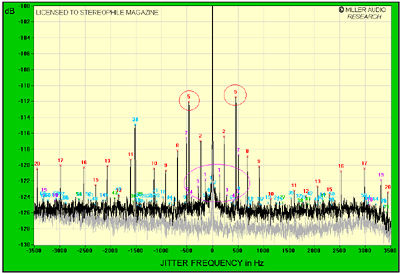| Columns Retired Columns & Blogs |
Or you can buy a Mac

Fig.6 Linn Kivor Oktal, spectrum of 50Hz sinewave, DC-1kHz, at 0dBFS into 100k ohms (linear frequency scale).

Fig.7 Linn Kivor Oktal, HF intermodulation spectrum, DC-24kHz, 19+20kHz at 0dBFS into 600 ohms (linear frequency scale).
Finally, I used Paul Miller's Jitter Analyzer to examine the Tunboks and Oktal's rejection of word-clock jitter. The analytical signal, consisting of a high-level 11.025kHz (Fs/4) sinewave over which has been overlaid a 229Hz squarewave at the -0.5LSB level (the latter is the owrst case for jitter generation as all 16 bits are switched simultaneously), was played back from the Tunboks. Interconnection to the Oktal was first a 1m Cat.5 cable, then the 50' Cat.5 cable used in my auditioning. The analyzer performed a high-resolution spectral analysis on the Oktal's analog output while it decoded this signal and searched the FFT bins for symmetrical sidebands around the central peak; the result is shown in fig.8. With the short datalink, the weighted sum of the jitter components was a low 261 picoseconds peak-peak. This increased slightly but inconsequentially to 271ps with the very long cable.
The highest-level sidebands are data-related, lying at ±229Hz (red "2" numeric markers), ±458Hz (229Hz x 2, red "5"), and ±687Hz (229Hz x 3, red "8"). However, jitter sidebands can also be seen at ±39Hz (purple "1") and ±508Hz (purple "7"); I don't know how these sidebands arise, but they do not contribute nearly as much to the total jitter as the data-related sidebands. A single spurious tone can be seen at 9.5kHz (blue "38").
The grayed-out trace in fig.8 is a spectrum taken from the analog output of Linn's Sondek CD12, which had one of the lowest levels of word-clock jitter I have ever measured with the Miller Analyzer: 137ps. Note that the expensive player's noise floor is around 3dB lower than the Oktal's, and that the central peak, representing the 11.025kHz tone, is more sharply defined. The rises in noise on either side of the tone with the Oktal suggest the presence of slight low-frequency random-noise jitter.

Fig.8 Linn Kivor Oktal, high-resolution jitter spectrum of analog output signal, Linn Tunboks source connected via 50' of CAT-5 cable (11.025kHz at -6dBFS with LSB toggled at 229Hz). Center frequency of trace, 11.025kHz; frequency range, ±3.5kHz. (Grayed-out trace is Linn Sondek CD12.)
Overall, this is a good set of measurements, particularly when you consider that the Oktal has eight pairs of identical D/A circuits for multirooom applications. However, I was disappointed that the processor would not lock to incoming datastreams with a sample rate higher than 88.2kHz, and that its resolution appears to be limited to 16 bits even with datastream bit depths greater than 16. These will not be issues for CD playback, however.—John Atkinson


... that you can run the SeeDeClip4 multiuser music server on a regular, noisy PC in the spare room and access and/or control the music using any modern gadget like a Chromebook, tablet, iPad etc.
This makes the choice of client easy - there's lots of cheap alternatives and an iPad can be hooked up to Toslink using an Apple TV or Airport Express etc.
The free version does a lot more than you'd think, it's a complete home audio solution.

A little late to the table(!), but thanks for an excellent, well-balanced review.
I was the systems architect of the Imerge SoundServer, which was rebadged (with some enhancements) as Linn's Kivor. I also designed the XiVA-Link communications protocol, and worked with Linn's Alan Clark (designer of the iconic Sondek CD12) on the S/PDIF hardware and drivers: Alan did most of the hardware work; I assisted in some of the FPGA firmware, and write the drivers.
I can confirm the accuracy of just about everything reported here. During 2000, both SoundServer and Kivor were going through a series of rapid evolutions. Towards the end of 2001, the products were settling down.
I'm a little surprised that they were reported as being MP3-only, though. One of the key selling points for audiophiles was that both products were able to rip and play uncompressed audio. This is why SoundServer (and, I believe, Kivor) came with up to 1.1 TB of storage - a massive amount at the time - configured as eleven 100 GB drives. It ran hot and heavy (and, yes, a bit noisy), but had enough elbow room to accommodate a lot of raw audio.
It was true that we only had one genre allocated to a track or album. This was partly because of the limited information we received from Gracenote. I always felt that having more than one genre per item in the database would be a good thing, but I was over-ruled. Apart from anything else, it would have made genre-based searches substantially slower, for a bunch of technical reasons it's not worth going into here. I think that if we'd done it today, we'd have used a noSQL database such as MongoDB or Couchbase, so we could have had the flexibility to enhance with additional fields such as user-assigned genres or arbitrary tags.
Anyway, thanks again. Great memories, revisiting that part of my career!
Jon